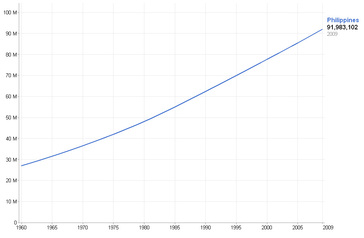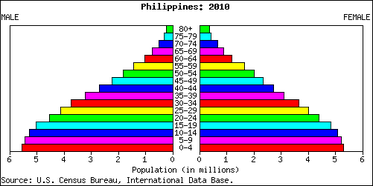Demographics: Population Growth

Figure 6: Population Growth of the Philippines (1960-2009) (Source: World Bank)
The population growth in the Philippines is slowing. The Philippines had a population of 88.57 million in 2007 (US Census Bureau) and although the population has increased to almost 98 million (CIA World Factbook) since, the rate of population growth has been slowing in recent decades, from an average of 3% per year in the 1960s to 1.9% since 2000. The Philippines is now in stage three of the demographic transition as it's birth rates and death rates are slowing in recent years.
- Birth Rate: 26.01 births/1 000
- Death Rate: 5.1 deaths/ 1 000
- Fertility Rate: 3.1
- Life Expectancy (total population): 71.09 years
- - Male: 68.17 years
- - Female: 74.15 years
Population Distribution

Figure 8: Population Pyramid of the Philippines (2010) (U.S. Census Bureau)
The slowing population growth reflects a fall in the fertility rate as seen in figure 9. It also reflects however, a fall in the birth rate and a fall in the death rate, as infant mortality rates have declined. Therefore, in turn, the crude birth rate declined greatly from 46/1 000 in 1960 to 30/ 1 000 in 2000 (Economist Intelligence Unit). At this time, family planning became much more widely accepted. But, the comparatively high rate of population growth means that the Philippines has a young population. In 2006, an estimated 35% of the population was under the age of 15 (Economist Intelligence Unit).


